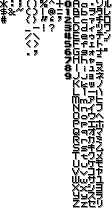Nintendo DSi
| Nintendo DSi |
|---|
|
Also known as: iQue DSi (CN)
|
| To do: Check for more unused content. |
The Nintendo DSi was Nintendo's half-generation upgrade version to the Nintendo DS. It added tons of new features, such as a Wii-like main menu, two cameras, a sound-recording app, a digital store for minor releases (some of which not so minor), real-time brightness change, WPA-1 and -2 wireless networking, and all of the features you would find on a regular DS. Well, if you ignore the lack of a GBA slot and artificial annoyances...
While hardly a commercial failure, relatively few software appreciatedly took advantage of its improvements compared to the Game Boy Color; the stopgap console only lasted for a few years before being succeeded by the Nintendo 3DS, yet continued to have very high profile releases for a couple of years owing to both the DS line's inertia and its successor's slow uptake.
Contents
Sub-Page
| Development Info |
| Prototype Info |
Hidden Button Combinations
| To do: How do region-locked DSi-exclusive and enhanced games react to this combo? |
Like the DS and 3DS, the DSi has a hidden button combination which is not documented in the DSi's instruction manual. There are two requirements which must be met in order for this combination to work:
- The system must not be set up. If the device has already been set up, it must be formatted so it boots into the setup screen.
- There must be a DS game inserted.
By holding A + B + X + Y + R while powering on, you can force a DS game to boot regardless of setting up the system. You will not be able to connect to a Wi-Fi network in this state. The system username, message, birthday, and alarm clock info will default as blank, and the system's favorite color will be set to color 15, the last option.
Debug Font
There's a leftover debug font titled debug/DebugFont.NCGR. However, there's no reference to the filename in the code. The uppercase is identical to the font used in the FDS version of The Legend of Zelda, with an added shadow.
Regional Differences
There's some minor language changes to each system menu. Notice how the US and Japanese versions have anti-aliased font, while the Korean and Chinese versions do not.
| Europe/US/Australia | Japan | Korea | China (iQue) |
|---|---|---|---|

|

|
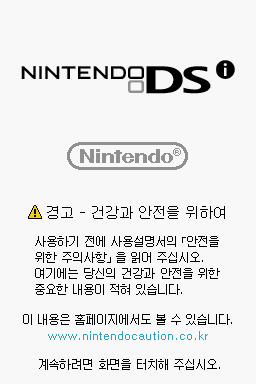
|
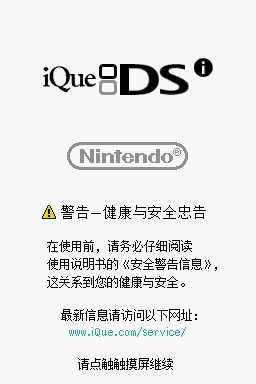
|
| Europe/US/Australia | Japan | Korea | China (iQue) |
|---|---|---|---|
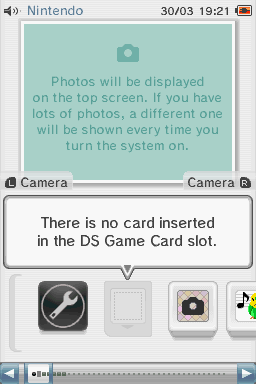
|
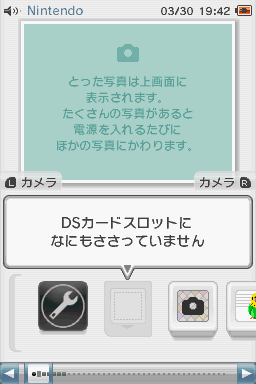
|

|
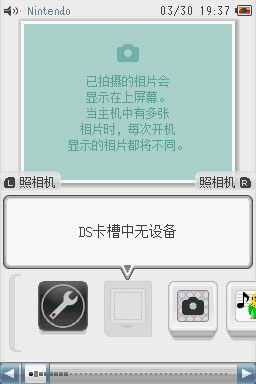
|
| Europe/US/Australia | Japan | Korea | China (iQue) |
|---|---|---|---|
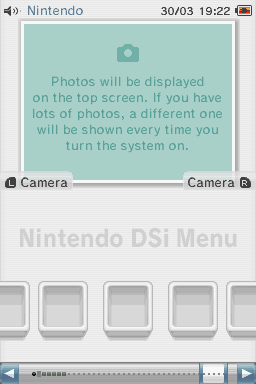
|

|

|
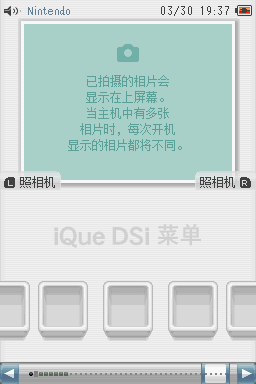
|
For DSi systems, the option for changing the DS language is only present in US and European firmware. Japanese, Korean, and Chinese models of the DSi do not have this option and default to their respective language if available (or English for non-Chinese models).
Revisional Differences
| To do: Make a start on this part. |
Version 1.3 added Facebook integration in the Nintendo DSi Camera app.
Anti-Piracy and Region Lock
While the DS does have some protections against game card dumping and unauthorized cards (which, by the start of 2007, were for most intents and purposes solved problems), the updateable DSi put up much more of a fight:
- The unmodified DSi (or 3DS in DS/DSi mode) blocks game card hotswapping outside of the main menu, by turning off power to the card slot.
- DSi ROMs could not be accurately copied with contemporary dumpers.
- All software intended to run on the DSi (regardless of whether it uses any DSi features) must have its header signed by Nintendo to be accepted, with a whitelisting database being used for older DS releases. Flashcard and cheat device manufacturers were forced to copy one off a licensed release, combined with a variety of methods - some of which countered by system updates adding checks that could not be emulated by contemporary products - to redirect execution to the desired code.
- For DSi software, inside the header is a list of hardware-enforced permissions; most notably, by Nintendo policy no consumer-facing title had both Slot-1 and eMMC/SD access. There's also a list of system regions on which the title is welcome.
- While some exploits were found during the console's heyday, the only one found in a digital title (Sudokuhax) was artificially crippled and also resulted in the title's delisting within approximately 3 hours, while gamecard-based ones are inconvenient to setup for negligible utility. The only true DSi flashcard, the CycloDS iEvolution, had poor compatibility in DSi mode. It took until 2018 for an usable full-access persistent exploit (Unlaunch), a few months more for an entrypoint to install it solderlessly (Flipnote Lenny), and another year for a different one not requiring optional software (Memory Pit).
This region lock was a huge source of confusion to concerned buyers, due to multiple factors:
- First and foremost, it only applies to DSi software: while easy to determine with the appropriate knowledge (the product code printed on the label and the back cover starts with TWL as opposed to NTR, and DSi exclusives have a white shell too), this wasn't widely understood at the time.
- Oceania (A, after the version number) is a separate region from the traditionally paired Europe (E), yet most releases have either none or both of these regions enabled (and the 3DS fully recombined them again).
- Finally, after all of that, The Pokémon Company thought it had enough: all non-Japanese versions of Pokémon Black and White and their sequels are enabled on all non-Chinese [sic] consoles!
Curiously, the DSi is immune to the region check of Chinese DS software.
- Pages missing developer references
- Games developed by Nintendo
- Pages missing publisher references
- Games published by Nintendo
- Games published by iQue
- Pages missing date references
- Games released in 2008
- Games released in November
- Games released on November 1
- Games with debugging functions
- Games with regional differences
- Games with revisional differences
- Games with anti-piracy methods
- To do
- DSiWare games
- BIOS/Firmware ROMs
Cleanup > Pages missing date references
Cleanup > Pages missing developer references
Cleanup > Pages missing publisher references
Cleanup > To do
Games > BIOS/Firmware ROMs
Games > Games by content > Games with anti-piracy methods
Games > Games by content > Games with debugging functions
Games > Games by content > Games with regional differences
Games > Games by content > Games with revisional differences
Games > Games by developer > Games developed by Nintendo
Games > Games by platform > Nintendo DS games > DSiWare games
Games > Games by publisher > Games published by Nintendo
Games > Games by publisher > Games published by Nintendo > Games published by iQue
Games > Games by release date > Games released in 2008
Games > Games by release date > Games released in November
Games > Games by release date > Games released in November > Games released on November 1
